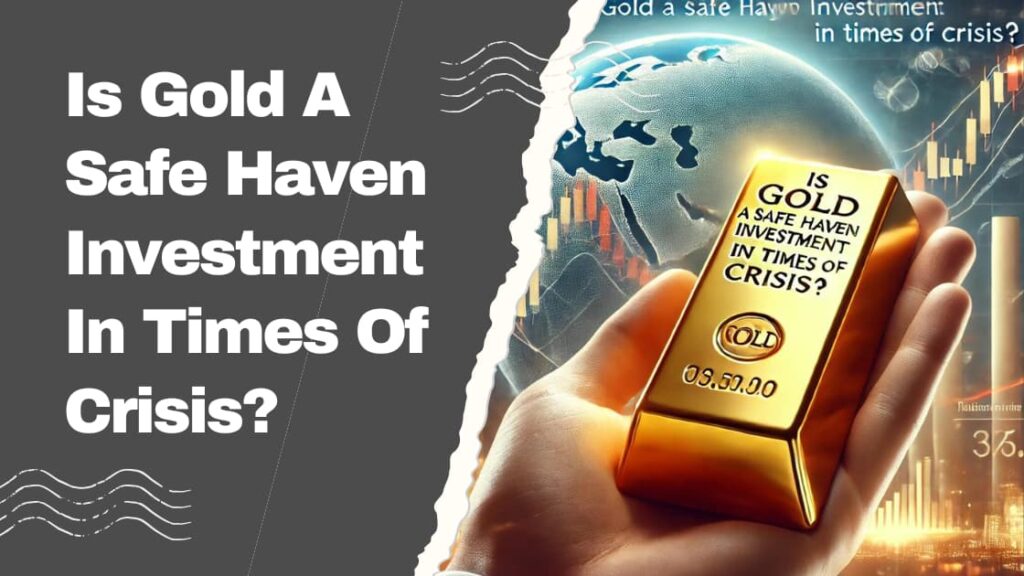When markets get shaky, you need a plan to keep your money safe.
Many people think gold is the best way to do that. But is gold really as foolproof as people say?
Let’s look at the real facts about how gold works in an investment portfolio. The truth may surprise you.
Understanding Gold’s Safe Haven Status
In the unpredictable world of finance, safe haven investments play a key role in keeping portfolios stable.
Gold, with its lasting value and historical importance, has long been seen as a top safe haven asset.
But what exactly makes gold qualify for this prized status, and how does it do when economic trouble hits?
Let’s look at the facts behind gold’s reputation as a financial shield.
What Makes an Investment a Safe Haven?
Safe haven investments are known for their ability to keep or increase in value during times of market trouble. To be a safe haven, an asset must have three main features:
- Stability: These assets usually show less ups and downs compared to the wider market, providing a steady anchor during economic storms.
- Liquidity: Safe havens can be easily turned into cash without greatly affecting their market price, offering crucial flexibility during crises.
- Universal Value: They are recognized and valued worldwide, going beyond geographical and political boundaries. This global acceptance is vital when economic uncertainty spreads across markets.
The thinking that drives investors towards safe havens is deeply rooted in avoiding risk. When markets become shaky, the fear of losing wealth pushes people towards perceived safety.
This behavior isn’t just an emotional response; it’s a basic principle in modern portfolio theory, stressing the importance of spreading investments to reduce risk.
Including safe haven assets in an investment portfolio serves as a financial buffer.
These assets help smooth out performance during market downturns, potentially keeping wealth safe when other assets are losing value.
This stabilizing effect is particularly valuable in times of economic uncertainty or political tension.
Gold’s Glittering Reputation in Times of Crisis
Gold’s status as the classic safe haven is built on a foundation of unique features and historical performance. Several factors contribute to gold’s perceived safety:
- Scarcity: Unlike regular currencies, which can be printed by central banks, gold’s supply is limited. This scarcity supports its value and makes it resistant to inflation.
- Durability: Gold doesn’t rust or decay, allowing it to keep its value over long periods. This physical toughness mirrors its ability to preserve wealth across generations.
- Global Acceptance: From ancient civilizations to modern economies, gold’s value has been universally recognized. This worldwide acceptance provides a level of security that few other assets can match.
Historical data backs up gold’s effectiveness as a safe haven.
Analysis of seven major crisis periods since 2007 shows that gold has averaged a return of 14.70%, significantly outperforming both the S&P 500 (-8.83%) and U.S. Treasuries (4.47%) during these troubled times.
This stark difference in performance highlights gold’s ability to not just keep wealth, but potentially grow it during periods of market stress.
Recent events have further cemented gold’s safe haven reputation.
During the COVID-19 pandemic, gold showed its resilience by outperforming other financial assets, including stocks.
Similarly, during the Ukraine-Russia conflict and recent U.S. banking crises, such as the collapse of SVB and Signature Bank, gold prices surged as investors sought refuge from political and financial uncertainties.
The cultural and historical significance of gold also plays a big role in maintaining its safe haven status. For thousands of years, gold has symbolized wealth and power across civilizations, a view that continues to influence its value in modern financial markets.
However, it’s crucial to approach gold’s safe haven status with a balanced view. While gold has proven its worth during many crises, its performance isn’t always positive across all types of market disruptions.
For instance, gold can be less predictable during scenarios like natural disasters, which may not directly impact financial markets.
Despite its long-standing reputation, it’s important to dispel the myth of gold’s perfection. Like any investment, gold has its limits and can experience periods of volatility.
The rise of digital alternatives, such as cryptocurrencies, has begun to challenge gold’s monopoly as the premier safe haven asset. However, gold’s established track record and physical nature continue to set it apart in many investors’ minds.
When considering gold as part of an investment strategy, it’s essential to view it as one part of a diverse portfolio.
While gold can provide a valuable hedge against market volatility, it shouldn’t be seen as a standalone solution to all investment risks.
Instead, it should be considered as one tool in a broader set of risk management strategies.
Gold’s Track Record
Understanding how gold has performed in the past during various economic and world events gives important insights for investors thinking about adding this precious metal to their portfolio. An examination of the historical data reveals gold’s performance when it matters most – during times of big market stress and global uncertainty.
Weathering Economic Storms
Gold has consistently shown strength during major economic downturns, often doing better than traditional assets. Here’s a closer look at gold’s performance during key economic crises:
The 2007-2008 Global Financial Crisis
During this time, gold proved to be a reliable safe-haven asset. While stock markets saw big losses, gold offered substantial protection to investors. According to Sprott Asset Management, during various crisis periods since 2007, gold has shown an average return of 13.98%, outperforming the S&P 500 which yielded -9.61% on average and U.S. Treasuries which delivered a mean return of 4.45%.
The COVID-19 Pandemic
The global economic shock caused by the pandemic in 2020 provided another test for gold’s standing as a financial safe harbor. As stock markets fell worldwide, gold once again did better than many other financial assets, strengthening its role as a preferred choice during severe market downturns.
The 1970s Stagflation
Looking further back, gold showed remarkable strength during the stagflation period of the 1970s. This era, marked by high inflation and slow economic growth, saw gold doing better than both stocks and bonds.
This past performance underscores the yellow metal’s capacity to serve as a bulwark against inflation and economic uncertainty.
It’s important to note that while gold has generally done well during economic crises, its behavior can vary depending on the specific nature of the economic challenge.
For instance, gold’s capacity to safeguard wealth can fluctuate based on the level of inflationary pressures. During times of moderate inflation, gold might not provide the same level of protection as it does during times of high inflation or economic turmoil.
Investors should also consider that past performance doesn’t guarantee future results. While gold has historically served as a safe haven, each economic crisis is unique, and gold’s performance may vary accordingly.
It’s crucial to analyze current market conditions and economic indicators when making investment decisions.
Shining Through Conflict
Beyond economic crises, gold has also shown its safe-haven qualities during times of world tension and conflict. Here’s how gold has responded to recent world events.
Russia-Ukraine Conflict
In March 2022, following Russia’s invasion of Ukraine, gold prices surged to new highs. This trend continued, with gold reaching record highs in subsequent months, driven by ongoing world tensions and increased central bank demand.
By April 2024, gold had reached record highs due to central bank demand.
US-China Trade Tensions
During the height of trade disputes between the United States and China, gold prices saw significant increases. Investors sought the perceived safety of gold amidst the uncertainty surrounding global trade relations.
Brexit Negotiations
The long and uncertain process of the United Kingdom’s exit from the European Union also saw gold prices rise as investors looked for stable assets amid the political and economic uncertainty.
Recent Banking Crises
The collapse of banks like SVB and Signature Bank in the U.S. led to a surge in gold prices, as investors flocked to safety amidst financial sector uncertainties.
It’s worth noting that gold’s performance during conflicts isn’t just about price increases. World events can have complex effects on gold markets, including impacts on mining operations, supply chains, and international trade in gold. For instance:
Conflicts can disrupt mining activities in affected regions, potentially leading to supply shortages and price increases.
Sanctions and trade disputes can significantly influence gold flows between countries, affecting both supply and demand dynamics.
World tensions can shift investor sentiment, potentially leading to increased demand for gold as a safe-haven asset.
While gold has demonstrated a consistent tendency to appreciate when geopolitical tensions rise, it’s crucial to understand that its performance can be influenced by many factors. These include the unique characteristics of the conflict, its potential economic impacts, and concurrent monetary policies of major central banks.
Gold has often shown more stability during world crises compared to other alternative investments. Unlike cryptocurrencies, which can be highly volatile during such periods, or real estate, which may be directly impacted by regional conflicts, gold typically maintains its global appeal as a reliable store of value during turbulent times.
For investors considering adding gold to their portfolios, it’s crucial to recognize its role as part of a broader diversification strategy.
Although gold often serves as a hedge against economic and global uncertainties, it’s not a cure-all for investment uncertainties.
Rather, gold should be viewed as a single piece within a well-balanced portfolio that includes a mix of assets tailored to individual risk tolerance and financial goals.
Factors Influencing Safe Haven Status
Gold’s standing as a safe haven investment is shaped by a mix of economic, world events, and market factors. Understanding these forces is key for investors thinking about gold as part of their alternative investment plan.
Now, we’ll explore the main elements that affect gold’s role in the global financial world.
Supply and Demand: The Scales of Gold’s Value
The balance between gold supply and demand is a basic driver of its value and safe haven status.
Global gold production trends have a big impact on market behavior, with major producing countries having a lot of influence.
As of 2024, the gold mining industry keeps changing, with new tech like automation and real-time data analysis reshaping production processes and possibly affecting long-term supply trends.
Recycled gold plays an increasingly important role in keeping supply steady, especially during times of high demand or production problems. This secondary source helps keep the market balanced and adds to price stability, a crucial factor for investors looking for portfolio stability.
Central bank policies have become a major force in gold markets. In 2023, central banks bought a record 1,037 tonnes of gold, with this trend continuing into 2024.
This trend shows growing trust in gold’s value and reliability, potentially enhancing its appeal as a financial shelter during uncertain times.
The size of these purchases can greatly affect global gold supply and demand patterns, influencing prices and market feelings.
The rise of gold ETFs has changed gold investment, making it easier for more investors to access.
In recent years, gold ETF holdings have seen big changes in response to economic uncertainties and changing market conditions. For example, renewed interest in gold as potential rate cuts draw closer has led to increased holdings across major exchange-traded funds.
This rise in demand through ETFs can have a substantial impact on gold prices and its perceived safety, offering a more liquid way to invest in gold without the complexities of physical ownership.
Currency Tides and Inflation Winds
Gold’s value is closely tied to currency movements, especially the US dollar. Historically, gold has shown an opposite relationship with the dollar, often going up when the dollar weakens.
This relationship is crucial for understanding gold’s role as a safe haven during currency changes. As of 2024, the interplay between gold prices and dollar strength remains a key consideration for investors navigating the complexities of global markets.
Gold’s reputation as an inflation hedge has been built over decades of market performance. During the 1970s stagflation period, gold showed remarkable strength, outperforming other traditional assets. This historical resilience highlights gold’s potential to preserve wealth when the purchasing power of currency erodes rapidly.
However, one must consider that gold’s effectiveness as an inflation hedge shifts based on the prevailing economic landscape. As of 2024, with inflation around 3% and central banks aiming to bring it down to 2%, gold’s role as an inflation hedge remains a topic of keen interest among investors.
The current low interest rate environment, including negative rates in some economies, has made gold more attractive.
When interest rates are low or negative, the opportunity cost of holding non-yielding assets like gold decreases, potentially increasing demand.
This dynamic has been particularly relevant in recent years, as central banks worldwide have kept accommodative monetary policies in response to economic challenges.
An important aspect to consider is gold’s behavior during deflationary periods. While traditionally seen as an inflation hedge, gold can also serve as a store of value during deflation, as investors seek tangible assets amid economic uncertainty.
This dual role enhances gold’s appeal across various economic scenarios, making it a versatile component in a diversified investment strategy.
In currency crises, gold often emerges as a favored asset. Its role as a potential future global reserve asset is a topic of ongoing debate among economists and policymakers, particularly in light of recent world tensions and economic uncertainties.
The upcoming November 2024 U.S. presidential election and its potential impact on gold prices further underscores the metal’s sensitivity to political and economic developments.
For investors exploring alternative investments, understanding these factors is essential.
Gold’s unique position at the intersection of world politics, economics, and market sentiment makes it a compelling option for portfolio diversification.
Nevertheless, a thoughtful approach to gold investment is imperative, requiring a nuanced understanding of these influencing factors, recognizing that its performance can vary based on a complex interplay of global events and economic conditions.
Gold vs. The Rest: Comparing Safe Haven Options
Understanding how gold compares to other safe haven options is key for building a strong portfolio. This comparison isn’t just about numbers-it’s about understanding the unique features that make each option good during times of economic stress.
Let’s look at how gold measures up against traditional safe havens like government bonds and new options like cryptocurrencies.
The Battle of Stability: Gold vs. Government Bonds
Gold and government bonds, especially U.S. Treasuries, have long been popular choices for investors looking for safety from market ups and downs.
However, their performance can be quite different depending on economic conditions.
Risk-Return Profile
Past data shows big differences in how these assets perform during crises.
Data from a leading precious metals investment firm indicates that across multiple economic downturns in the last 15 years, gold showed an average return of 14.70%. This outperformed the major stock market index and government bonds, which yielded 4.47%.
This big difference shows gold’s potential not just to keep wealth but to grow it during tough times.
Liquidity
Both gold and government bonds offer high liquidity, which is crucial during market stress.
However, gold can sometimes experience wider price gaps between buyers and sellers during extreme market swings, potentially impacting short-term transactions.
On the other hand, the U.S. Treasury market, being the largest and most active globally, typically maintains narrow bid-ask spreads even under challenging conditions, ensuring smoother trading experiences.
Historical Performance
During government debt crises, gold has often done better than government bonds. However, it’s worth considering that the precious metal’s role as a financial safeguard fluctuates based on the nature of the crisis.
For example, studies have shown that during health-related crises like pandemics, government bonds have sometimes done better than gold. This was seen during outbreaks like COVID-19, SARS, Ebola, Zika, and Swine Flu, where gold was found to be a weaker safe haven compared to U.S. treasuries and Japanese government bonds.
Interest Rate Impact
Interest rates greatly affect both gold and bond performance, but in different ways. Rising rates typically push gold prices down but can benefit bond yields.
Conversely, the low or negative interest rates seen in recent years have made precious metals that don’t generate income more attractive.
As of 2024, with expectations of possible rate cuts by the Federal Reserve, gold has seen new interest, sparking a surge in investments through popular gold-backed ETFs.
Tax and Storage Considerations
Government bonds generally have better tax treatment and lower storage costs compared to physical gold. However, new ways to invest in gold, such as ETFs and digital gold platforms, have reduced some of these drawbacks.
These modern investment options give exposure to gold without the hassles of physical ownership, making gold more accessible to more investors.
Digital Gold? Cryptocurrencies as Emerging Safe Havens
The rise of cryptocurrencies, especially Bitcoin, has brought a new angle to the safe haven debate. Often called “digital gold,” cryptocurrencies have both similarities and big differences compared to traditional safe haven assets like gold.
Volatility and Adoption
The difference in price swings between gold and cryptocurrencies is big. While gold prices can go up and down, these movements are typically less dramatic than the swings seen in cryptocurrency markets.
For example, the iShares Gold Trust ETF experienced a maximum drop of nearly 43% over 17 years, which, while significant, is much less than the volatility often seen in cryptocurrency markets.
This high volatility in cryptocurrencies can present both opportunities and risks for investors.
Cryptocurrency adoption is growing, especially among younger people. This trend could change future views of safe haven assets.
The increasing use of cryptocurrencies in mainstream financial systems and the development of crypto-based financial products are signs of growing acceptance.
Regulatory Landscape
Gold benefits from established rules worldwide, providing a level of certainty for investors.
In contrast, cryptocurrencies face a changing and often uncertain regulatory environment. This uncertainty about rules can affect their perceived safety and stability.
As of 2024, many countries are still figuring out how to regulate cryptocurrencies effectively, which adds an extra layer of risk for investors considering them as safe haven assets.
Environmental Concerns
Both gold mining and cryptocurrency mining have faced criticism for their environmental impact.
Gold mining has long been criticized for its ecological footprint, including cutting down forests and polluting water. However, the industry has been making progress in adopting more sustainable practices.
Cryptocurrency mining, particularly for Bitcoin, has been criticized for its huge energy use. However, innovations in both sectors are addressing these concerns.
For cryptocurrencies, there’s a push towards more energy-efficient methods. In the gold sector, blockchain technology is being explored to improve transparency and efficiency in gold trading and ownership verification, potentially offering more sustainable solutions.
Blockchain Potential
The use of blockchain technology in the gold industry represents an interesting mix of traditional and digital assets.
Blockchain can potentially revolutionize gold trading by providing unchangeable records of ownership and origin, reducing fraud, and increasing market efficiency.
This technological integration could bridge the gap between traditional gold investments and the digital asset space, potentially making gold more appealing to tech-savvy investors.
As the safe haven landscape changes, it’s clear that while gold keeps its status as a time-tested safe haven, new options like cryptocurrencies are creating their own space.
The choice between these assets ultimately depends on individual risk tolerance, investment goals, and views on the future of the global financial system.
In an increasingly complex investment world, understanding the details of each option is key to building a strong and diverse portfolio.
For investors considering these safe haven options, it’s crucial to:
- Assess your risk tolerance and investment timeline.
- Consider the role of each asset in your overall portfolio diversification strategy.
- Stay informed about regulatory developments, particularly for newer assets like cryptocurrencies.
- Evaluate the liquidity needs of your portfolio and how each asset fits those requirements.
- Consider the tax implications of different investment vehicles for each asset class.
- Monitor global economic conditions and how they might impact the performance of each safe haven option.
The Golden Decision: Pros and Cons for Investors
When thinking about different investment options, gold often stands out as an interesting choice. However, like any investment, it has its own set of good and bad points.
It’s worth examining the potential benefits and drawbacks of adding gold to an investment portfolio.
Potential Benefits of Gold in a Portfolio
Gold’s ability to spread risk in a portfolio is one of its main advantages. Research shows that putting 5-10% of a portfolio in gold can greatly lower the chance of loss and reduce big swings in value.
This benefit comes from gold’s tendency to move differently from stocks and bonds. During the 2007-2008 financial crisis, for example, gold showed its strength by giving positive returns, outperforming conventional investment options and proving its role as a portfolio stabilizer.
Tangible Asset in a Digital World
In a time where digital assets are common, gold’s physical nature offers unique benefits. Unlike cryptocurrencies or stocks, physical gold can’t be hacked or affected by computer system failures.
This real-world quality offers a tangible safeguard that can be especially valuable during periods of financial instability or tech problems. Also, gold is recognized worldwide as something of value, making it an asset accepted globally.
Inflation Protection
Gold has shown it can keep its buying power over long periods. During times of rising prices, gold often keeps its value better than currencies, acting as a good defense against the loss of wealth.
This feature is particularly important in today’s economy, where rising prices and changing currency values are ongoing worries for investors.
Psychological Stability
The mental benefits of owning gold during market trouble are significant. Gold’s history as a safe investment can give investors a sense of security during economic crises, potentially stopping panic-driven decisions that could harm long-term financial goals.
This emotional stability can be crucial in sticking to a disciplined investment approach during shaky market conditions.
ESG Considerations
The gold industry is making big steps in the area of ESG (Environmental, Social, and Governance) investing. Many mining companies are using more sustainable practices, focusing on reducing environmental impact and improving social responsibility.
For example, some major gold mining companies have promised to achieve net-zero carbon emissions by 2050. Also, the industry is exploring blockchain technology to enhance traceability and authentication in the gold supply chain, potentially making gold more attractive to socially conscious investors.
Potential Drawbacks of Gold Investment
One big drawback of gold investment is the opportunity cost. Unlike stocks or bonds, gold doesn’t generate income through dividends or interest payments.
This lack of yield can be a substantial disadvantage, especially during periods of economic growth and rising interest rates. Investors must rely solely on price increases for returns, which can be unpredictable and may not happen in the short to medium term.
Price Volatility
While gold is often seen as a stable asset, its price can change a lot in the short term. To illustrate this volatility, consider that gold-backed securities have seen significant declines, with one prominent fund dropping by about 42.59% over 30 years.
This volatility can be caused by factors such as currency changes, world events, and changes in monetary policy. While gold tends to do well during crises, its price can swing significantly in response to various economic indicators and world events, making it hard to time the market.
Storage and Insurance Costs
Owning physical gold comes with extra costs and practical considerations. Storage and insurance expenses can eat into potential returns, and secure storage facilities may not always be easy to access.
These costs can be particularly burdensome for smaller investors, potentially offsetting some of the benefits of gold ownership. For instance, yearly storage fees for physical gold fluctuate based on the storage method and amount of gold held.
Liquidity Challenges
While gold ETFs are easy to buy and sell, physical gold or certain gold-backed securities may be harder to convert to cash quickly without affecting the price.
This can be problematic for investors who may need to access their funds on short notice or during times of market stress.
The difference between buying and selling prices for physical gold can widen during periods of market volatility, potentially affecting the price at which investors can sell their holdings.
Technological Impact on Demand
New technologies pose a potential threat to gold’s industrial demand. As alternatives are developed for gold’s use in electronics and other industries, this could impact its overall demand and, as a result, its price.
While gold’s main value lies in its investment and jewelry demand, any reduction in industrial uses could affect its long-term price trends. For example, some electronics manufacturers are exploring alternatives to gold in certain components due to cost considerations.
Complexities of Gold Mining Stocks
Gold mining stocks, while offering exposure to gold, may not closely follow the spot price of gold due to operational risks and profitability differences among miners.
This introduces a further dimension of intricacy for investors seeking pure gold exposure. Factors such as management decisions, production costs, and political risks in mining locations can all impact the performance of gold mining stocks, potentially leading to differences from gold price movements.
The Midas Touch: Incorporating Gold in Your Investment Strategy
Adding gold to a modern investment portfolio requires more than just buying gold coins or shares in a gold ETF.
It needs a planned approach to improve portfolio strength and performance.
This section looks at the details of effectively adding gold to your investment strategy.
Golden Rules for Portfolio Allocation
The best amount of gold to have in a portfolio is still debated among financial experts. However, they generally agree on a range that balances risk reduction with return potential.
Research shows that allocating between 5% and 10% of your investments to gold can significantly minimize the risk of loss and volatility in your overall portfolio value.
Here’s a breakdown of different allocation models and their potential impacts:
- Conservative Model (2-5% allocation): This approach is good for investors who don’t like much risk. It aims to provide some protection during market downturns without greatly affecting overall returns during good market times.
- Moderate Model (5-7% allocation): This balanced approach tries to show substantial protection against losses while still allowing for gains in good markets.
- Aggressive Model (7-10% allocation): For investors seeking maximum benefits from spreading their investments, this model aims to provide stronger protection during severe market stress, although it might slow down returns during strong market upswings.
Investors should be aware that gold’s performance can vary a lot based on economic conditions. Past trends show gold doing well during economic downturns, but it’s crucial to remember that historical patterns may not predict future outcomes.
Gold’s past performance as a safe investment has shown mixed results, with some studies suggesting it can do well during certain economic downturns but may still go down during severe financial crises.
It’s crucial to note that gold investments aren’t free from big price swings.
The iShares Gold Trust ETF, for instance, saw its value plummet by almost half over a span of nearly two decades.
This shows the importance of keeping a balanced approach to gold allocation.
Rebalancing strategies are key to maintaining the right amount of gold exposure. Two effective approaches include:
Calendar Rebalancing: Adjust your gold allocation back to the target percentage at set times, such as every three or twelve months.
Threshold Rebalancing: Rebalance when your gold allocation changes by a set percentage (e.g., 20%) from your target. This method responds more to market movements but may cost more in transaction fees.
When using these strategies, consider your overall investment goals, how much risk you’re comfortable with, and market conditions. Regular review and adjustment of your gold allocation, considering changing circumstances, will help ensure that your portfolio keeps its intended balance.
Tech Meets Tradition
In today’s tech-driven investment world, gold plays a unique role in complementing high-growth tech investments. The relationship between gold and tech stocks changes across market cycles, often showing an opposite relationship when financial markets face turbulence.
Here’s how gold can work alongside tech investments:
Tech stocks are known for their high growth potential but also for their big price swings. Gold’s typically low connection with tech stocks can help smooth out portfolio returns.
During tech sector downturns, such as when the dot-com bubble burst, gold has historically provided a cushion for portfolios heavily invested in tech stocks.
In a situation where tech companies may struggle with rising costs, gold can serve as a protection against inflation, potentially safeguarding overall portfolio value.
Strategies for using gold to protect against tech sector volatility include:
- Keep a consistent gold allocation (e.g., 5-7%) and rebalance regularly. This approach provides ongoing protection without trying to time the market.
- Adjust gold allocation based on market conditions or when technical indicators suggest increased market risk.
- Use gold ETF options as a cost-effective way to protect against potential tech sector drops.
The integration of digital ledger systems in gold trading blends cutting-edge technology with time-honored practices. This development is enhancing the clarity and streamlining operations within gold markets, making the precious metal more attractive to tech-savvy investors.
Some companies are now offering gold-backed tokens, combining the stability of gold with the efficiency of blockchain technology.
Advances in gold mining technology are affecting the supply side of the equation. New methods in extraction and sustainability practices are changing the landscape of gold production, potentially affecting long-term supply dynamics and, as a result, gold prices.
We should keep in mind that as technology makes gold investment more accessible, it also introduces new risks. Cybersecurity concerns, regulatory challenges with digital gold products, and the potential for technology-driven market manipulation are factors that investors need to consider.
The Future of Gold: Safe Haven 2.0
The gold market is going through big changes, driven by new tech and changing economic landscapes. These developments are reshaping how investors view and utilize gold as a financial shield during uncertain times.
Understanding these changing dynamics is crucial for those considering gold as a component of their investment strategy.
Emerging Trends in the Gold Market
Blockchain technology is bringing new transparency and efficiency to the gold market. This innovation is particularly important for investors looking for alternative options.
Blockchain Technology and Tokenization
By creating an unchangeable record of transactions, blockchain has the potential to reduce fraud risk and boost trust in gold trading systems.
Tokenization, a blockchain-based process, is broadening the appeal of gold to a more diverse investor base.
Digital tokens representing gold ownership allow for fractional investing, potentially lowering the entry barrier for new market participants.
This development could expand opportunities for gold investment and impact long-term demand dynamics.
Environmental Considerations and Ethical Sourcing
The gold industry is increasingly focusing on sustainable and ethical mining practices. This shift is not just about environmental care; it’s reshaping the economics of gold production.
Investors concerned about environmental, social, and governance (ESG) factors are driving demand for responsibly sourced gold. This trend is leading to the development of “green gold” products, which could potentially command higher prices in the market.
Artificial Intelligence in Gold Trading
Artificial Intelligence (AI) is changing gold price prediction and trading strategies.
Advanced algorithms analyze huge datasets, including economic indicators, world events, and market sentiment, to forecast gold price movements.
For investors, AI-driven insights can provide additional data points for decision-making.
However, it’s important to remember that while AI enhances analysis capabilities, it doesn’t eliminate market risks.
The Concept of Space Mining
While currently theoretical, the concept of space mining has entered discussions about the long-term future of gold supply.
Asteroids rich in precious metals could theoretically increase the global gold supply. Although this scenario is likely decades away from happening, it represents a potential long-term factor that forward-thinking investors might consider in their analysis of gold’s future scarcity-driven value.
Potential Threats to Gold’s Safe Haven Crown
Real Estate Investment Trusts (REITs) are emerging as a compelling alternative for investors seeking safe haven assets.
Rise of Alternative Assets
Unlike gold, REITs offer the potential for regular income through dividends, making them attractive in low-interest-rate environments.
The global REIT market has shown significant growth in recent years.
Central Bank Digital Currencies (CBDCs)
The development of CBDCs by major economies could potentially impact the yellow metal’s standing as a hedge against fiat currency risks.
As of 2024, numerous countries are in various stages of CBDC development and implementation.
The widespread adoption of CBDCs could reshape monetary policies and potentially affect gold’s traditional safe haven status.
Growing Popularity of Silver and Other Precious Metals
Silver, with its lower price point and industrial applications, is gaining traction as an alternative to gold.
The silver market has seen increased investor interest, particularly during periods of economic uncertainty.
Other precious metals like platinum and palladium are also attracting attention due to their critical roles in emerging technologies.
Regulatory Changes and Tax Implications
The regulatory landscape for gold investments is evolving. Changes in tax policies, such as potential reclassification of gold for tax purposes, could significantly impact its attractiveness as an investment.
Investors should stay informed about regulatory developments in their areas, as these could affect the after-tax returns on gold investments.
Long-term Economic Scenarios
Certain economic scenarios could potentially lessen gold’s safe haven appeal.
A long period of global economic stability and low inflation might reduce the perceived need for gold as a portfolio stabilizer.
Additionally, if central banks successfully maintain price stability through new monetary tools, it could change the traditional inflation-hedge story for gold.
As the investment landscape continues to evolve, staying informed about these trends and potential challenges is crucial.
While gold maintains its historical importance as a safe haven, the changing financial ecosystem demands a nuanced understanding of its role in modern portfolios.
Investors should consider these factors when evaluating gold’s place in their investment strategies, always keeping in mind their individual financial goals and risk tolerance.
Conclusion
Gold offers wealth protection but has limits. It does better than stocks and bonds in crises yet lacks income and has storage costs.
Put 5-10% of your portfolio in gold and rebalance often. Learn about blockchain used with gold trading and sustainable mining.
Take action now. Look at your portfolio. Research gold choices matching your goals. Talk to a financial advisor about the right amount of gold for you.
Don’t wait – make your financial future secure today.










